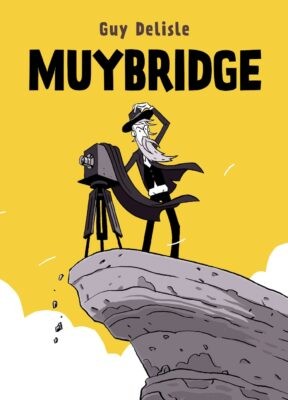Veteran and award-winning graphic novelist Guy Delisle takes a bold new turn with his latest release Muybridge. Unlike his thirteen previously translated works, mainly travelogues and autobiographical narratives, his new book is a compelling biography of Eadweard Muybridge, the pioneering photographer often credited as the father of motion pictures.
For those who are technically wary, fear not. Delisle, a Quebec City native, makes the story both engaging and accessible, weaving in concise explanations of technological concepts alongside his trademark wit and light humour. His simple, clean-lined drawings are set in monochrome sepia hues to reflect nineteenth-century photography, with colour used sparingly for dramatic contrast and emphasis.

Muybridge
Guy Delisle
Drawn & Quarterly
$34.95
cloth
216pp
9781770467729
Capturing this was an amazing feat and a photographic breakthrough. In his native England of 1882, Muybridge’s work became the subject of much interest and acclaim. He gave lectures to sold-out crowds. However, just when he was about to give a talk at the Royal Society, the country’s most respected scientific institute, he was unexpectedly uninvited and accused of fraud. Leland Stanford had commissioned another man to author the book Horse in Motion, which included ninety pages of illustrations based entirely on Muybridge’s photographs. In the book, Muybridge was listed as a mere technician. The photographer, outraged, filed a lawsuit, which was later dismissed.
Throughout his life, Muybridge experienced great triumphs and colossal setbacks. His photographs were sold in galleries and bookshops. But Muybridge really made a name for himself in the US as a landscape photographer for his pictures of Yosemite, which were published around the world. He later went on to do the first panorama of San Francisco, and to photograph the new state of Alaska and the Modoc war in Oregon. While travelling across the US by stagecoach, he was in an accident and suffered a head injury. It is said that afterward, he became more aggressive and impulsive.
Undoubtedly, Muybridge’s most notorious misadventure was killing his wife’s lover, a dramatic episode that Delisle vividly renders in a thirty-six-panel sequence. Echoing Muybridge’s own motion studies, Delisle’s panels capture each critical moment: Muybridge firing the pistol, the bullet’s impact, and finally, him dropping the weapon. Delisle decelerates the action, emphasizing how, in a single, impulsive and irrevocable moment, Muybridge’s life was transformed.
In the graphic novel, Muybridge is indeed a complex, albeit unlikeable, character. Delisle skillfully captures both his cantankerous personality and his relentless, single-minded determination – qualities that propelled him to innovative heights in photography. However, the book is about much more than just the man. It also highlights the rapid, near-contemporaneous advances in photography and motion pictures on both sides of the Atlantic in the mid- to late nineteenth century – and Muybridge’s contributions to both.
The cartoonist’s interest in Muybridge comes as no surprise. As a graduate of Sheridan College and a former animator, Delisle, like many other animation students, pored over Muybridge’s groundbreaking motion studies. Muybridge’s books, though not commercially successful in his lifetime, are still in print today and considered foundational texts for students of animation.
This work is thoroughly researched and well documented. Alongside his own panels, Delisle provides the iconic photographs that made Muybridge famous, credited at the end. An ambitious and highly successful undertaking, replete with historical facts (some are more interesting than others), this is Delisle’s best work to date and a hard act to follow.mRb






0 Comments